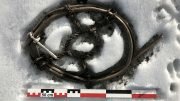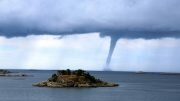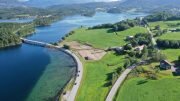In case you missed it, we’ve already covered whether ice archeologists have the coolest job on earth (hint: they do). In this article, we’re taking it up a notch. Live the Arctic treasure hunter life vicariously with this glimpse into 24 hours in the life of an ice archeologist in Norway.
Secrets of the Ice‘s own Dr. Lars Holger Pilø shows us what being an ice archeology is really like.
We’ll begin by looking into finds, which are, of course, the goal of ice archeology, and then we’ll break down how such objects are actually uncovered, step by step.
Discovering millennia-old artifacts
What sort of artifacts do ice archeologists find?
“The oldest finds we have are 6,000 years old, and these are arrows. Those are from deep inside the Stone Age.
“Another of the oldest finds was a 3,400-hundred-year-old shoe made of animal hide, which was discovered in 2006. In fact, this shoe was sort of the thing that kicked off the work because it was such a unique find, and we didn’t understand how it could be preserved. That was sort of the starting point for everything.
“When we get into the Bronze Age, which happened about 1,700 years BC, then we start getting other finds.
“On hunting sites, we basically know what we’re going to find. There are many arrows lost in the snow here. And, if we’re really lucky, we find broken bows. There’s also a special object present on hunting sites which we call a “scaring stick”. This was placed in a fence and used to guide the reindeer towards where the hunters were hiding out.
“As we get into the Iron Age, especially when we get into the finds from the lost Viking mountain pass at Lendbreen, we get a much wider impression of material cultures. You can find basically anything in a mountain pass because people traveled through there, they dropped stuff, and they threw it away. On such areas of transport, like Lendbreen, you can find almost anything; clothing objects, tools, and random items that people dropped on the way, that were just lost.
“I like the hunting sites as well, they are great, but the mountain pass sites are something special”, says Dr. Pilø.
Do you have a favorite find?
“This is difficult, this is like asking me to choose between my children, I can’t do that!” Dr. Pilø laughs.
“But, there’s one find that I like in particular and it’s not something flashy, it just touches me.
“We found, in the Lendbreen mountain pass, a very short arrow. It’s 26 centimeters long, and it’s not sharp on one end like an arrowhead, but it’s blunt.
“We discussed this with archery specialists, and they say that you can’t kill anything with that arrow because it’s so short and doesn’t have any impact power.
“The conclusion is that it’s a toy arrow. It’s dated to AD 600 so it’s 1400 years old, and it was up at the top of the mountain pass at Lendbreen.
“As a scientist, I shouldn’t say this, but it touches me because I sort of feel connected to the child that lost it. He or she was probably playing when they got to the mountain pass during a rest and shot it into the snow. When they lost it, they were probably very unhappy about that.
“They might’ve thought ‘Oh, it’s gone forever,’ but it wasn’t! Because it came out of the ice 1400 years later.
“To me, that’s a very special find. Of course, we have a number of other great finds, but that’s a special one.”
24 hours as an ice archeologist: Arriving at the basecamp
“The way our days in the field start off depend. Different types of archeological surveys actually determine the course of our day.
“We can sometimes do what I call ‘hit and run’ surveys. These mean that we normally rush up in the morning, check out if there are any finds, and go down in the evening.
“For this, you don’t carry too much equipment, and you can just do it in one day if it’s a small site.
“The larger sites, however, need proper systematic surveys. That’s a completely different story.
“On larger ice sites, we get up each morning with the sun and live out of a basecamp.
“We used to take the equipment for the basecamps in with helicopters, but we are trying to reduce our carbon footprint. So, we have decided to rely on horses. We use packhorses to transport in the equipment.”
“We have to bring all the necessary equipment.
“Obviously, we need something to measure the exact location of the finds – and that is a high precision GPS. We use those mainly for the big surveys because they are quite bulky and difficult to carry. But we also have handheld GPSes that have less precision. We use these for the ‘hit and run’ surveys when we just go in and check if there’s something.
“Then, of course, we need the finds equipment which is normally a box with different tools in it. For example, a scale for photos.
“We don’t actually do a lot of excavation, because we mainly collect stuff that has already melted out.
“If it still happens to be stuck in the ice, which has happened a few times, we will bring part of our kitchen along. This is basically a water boiler kettle where we heat water, not so that it becomes steaming hot but just lukewarm. We’ll pour that onto the ice to free the object.
“That’s something which I don’t think you’ll find on many other surveys.
“So, aside from the GPS, it’s actually quite low-tech. That’s also something we have decided on because it can be rough up there for very complex equipment technical equipment. It’s easier to have low tech equipment that works well even when the weather is bad.
“Normally, we also have one tent each and then we have a common mess tent where we can stay when we’re not working. We try to have our base camps as close to the ice as possible, to try to avoid having to climb 500 meters in the morning.
“We have to be very careful on the rough terrain, and that also means that we have to have really good equipment. Regular tents are not good enough because there’s a lot of wind up there. We have Everest-rated tents and equipment for the fieldwork.
“So, we get up very early and have our breakfast in the mess tent. Then, we get all our equipment and head out.”
Scaling ice patches and finding artifacts
“To stay warm outside when we head out, a whole lot of woolen clothing is really necessary, along with proper jackets.
“It’s a bit funny, because as we walk up to the site, we usually just wear our wool underwear, a shell jacket, and trousers because we get so warm from walking up the hill. But then, when we get up there, we have to immediately put on more clothes, because we start to walk slowly and get cold immediately.
“Normally, what we do is set up a line of surveyors with two meters in between each other, and then we walk right along the edge of the ice. We measure the edge of the ice so we know where it is when we’re surveying.
“It’s important to walk slowly and look very carefully between the rocks because there are a lot of loose stones there.
“We have been lucky so far in terms of safety. We’ve had a few falls, which can happen, but no broken ankles. We are really careful up there.
“Sometimes, we get a really bad melt and the ice surface becomes exposed, and then we only work there if we put on crampons. These ensure that we don’t start sliding off the ice because once you start sliding there, you’re gone.
“After the ice age, there were moraine deposits in some areas but they’ve been washed out. So, now the surface is covered with scree, that is, a lot of small stones lying on top of each other.
“If we survey in a steep slope with loose rocks we take care that our line is situated in a way that people won’t drop rocks onto the person below once they start moving.
“It can also happen that artifacts fall in between the cracks. So, it takes quite some time to survey it properly.
“Every time we make a find whether it’s an artifact, material from reindeer, anything, we put down a marker and walk on.
“Then, when we have a number of finds, a group will separate from the survey team. This is the finds team, who takes care of collecting and documenting the finds, measuring exactly where they are and using a GPS, while the rest of us continue the survey.
“By the end of the day, we try to have collected everything that we found that day. So, we end with a fully measured survey area in which we’ve collected everything.”
Post survey: Sleeping under the stars
“People can get really tired because it’s quite exhausting up there with the wind, rain, and altitude. It’s up to 2,000 meters so there’s a little less oxygen. If you’re up there for a couple of days, you start to feel really tired in the evenings.
“At the end of the day, one way or the other, we’ll go down to the mess tent, deal with the finds, talk and tell stories, and have dinner.
“The type of food we eat depends. If we have to carry our own food up, we normally eat freeze-dried foods. When we have packhorses, we can bring fresh food as well.
“The thing is, we’re so close to the ice and snow that we can basically just use it as a refrigerator, put all the fresh food into the snow, and bury it there.
“But, we have to bury it deep enough, so we don’t get wolverines eating it at night. But they normally stay away from where we are. They are quite shy.”
After the dig is done
What happens to objects after a dig is over?
“Once a find has been collected, it’s given a specific number. We take the finds down with us when we leave the sites and transport them to a local museum in Lom, in the mountain region where we work. Finds are kept there while the fieldwork is ongoing.
“The ice is a time machine. Our finds usually haven’t aged the way that finds from other environments do.
“So, they’re really well preserved, and they don’t actually need much conservation. They just need light cleaning and being dried out in controlled conditions.
“Some finds do need a little more work. For example, we found an Iron Age tunic which needed freeze-drying for 14 days to get rid of all insects and everything that was on it.
“In general, though, they need little conservation.
“They are also dated. We can sometimes use what we call typological dating, which is dating by the shape of the artifacts. We can do a little of that especially for the arrowheads and horseshoes, which are more or less the only iron objects that we find up there.
“Otherwise, objects are dated using the radiocarbon method. Artifacts we find are often made of organic materials, which are normally not preserved in the lowlands. However, that makes it very difficult to date them with typology because we have nothing to compare them with.
“After that, the museum team gives the finds descriptions and enters them into the museum catalog. Some of the finds are exhibited at the local museum in Lom.
“We collaborate with the museum and publish scientific papers on the objects and the sites.”
A short window for fieldwork
Ice archeologists don’t always spend their time traversing the high mountains of Norway in search of hidden treasures; such pursuits are reserved for only part of the year.
How often are you actually in the field?
“We normally have quite a short time window each year where we can do fieldwork. The reason for that is we work in the high mountains. So, we need the snow from the year before to melt first.
“Then, we can work until the snow from the next winter comes.
“So, our fieldwork period is normally between four to six weeks, and it takes place in August and September each year.”
Since there’s such a short window for fieldwork, what does the rest of the year look like for you?
“It’s report writing, research, outreach work, and of course there’s also other work to do at the Heritage Department.
“I work with the use of LiDAR for area laser scanning, and I also work in cooperation with private metal detectors. But, the glacial archeology is obviously the main bulk of my work.”
All in all, it’s a team effort
“Our team normally has a field director, which is either me or Espen Finstad. We also have a person who is responsible for finds, a person who is responsible for the measurements of the finds, and a person responsible for the supervision of the survey team – basically, that they do things properly, walk at a correct distance and correct speed.
“Sometimes we also have volunteers. Especially local people, but we have also taken in a few volunteers from outside Norway on occasion.
“For the last field seasons, we brought our own cameraperson, so we have one person filming the whole thing. The reason is that we get a lot of attention and requests from TV production companies. I think we have 20 or 25 now.
“However, those have never actually panned out, and the reason for that is that the weather up there is so unpredictable that we can’t promise that we will make finds a certain year. That depends on the melting, and we only know that during the summer.
“Also, they could fly in from far away and then suddenly we get 20 cm of snow. You can get this in August in the high mountains, no problem.
“That’s obviously difficult for the production companies who want to pitch a series on what we do. We can’t promise anything. That’s why we film our own stuff and bring our own cameraman”.
So now you’ve gotten a glimpse into the life of an ice treasure hunter.
Next, you can check out some of the scientific publications that have been created as a result of this meticulous, challenging, and exciting work.
Read all about the papers written so far – and stayed tuned for future discoveries! – on the Secrets of the Ice website.
Photos and photo information courtesy of Secrets of the Ice.
Source: Norway Today





Many years ago while on a retreat in Albuquerque, New Mexico, USA, I went walking in the desert, came across a dump, and, walking over the dump, found a toy corn pounding stone designed for a very small girl’s hand. It is a beautiful white/orange mix, the color of a sunset against the snow-capped mountains. Though I had never been able to get pregnant, I found myself pregnant 8 months later and delivered my daughter eight months after the pregnancy began. As you cherish your toy arrow, I will always cherish this toy corn-pounding stone.